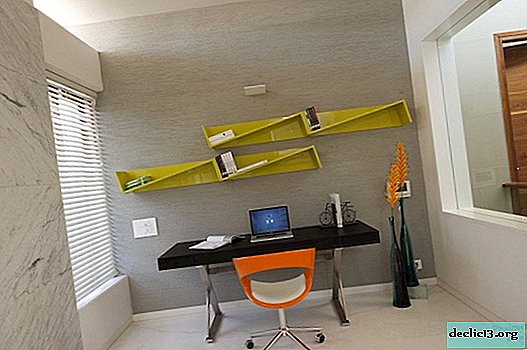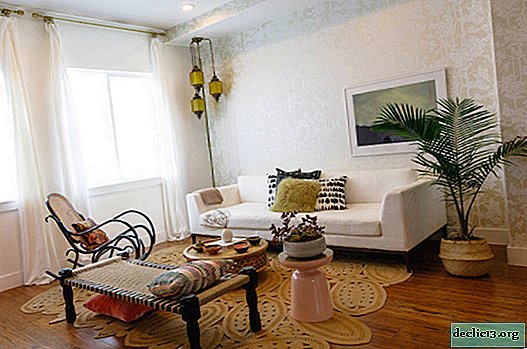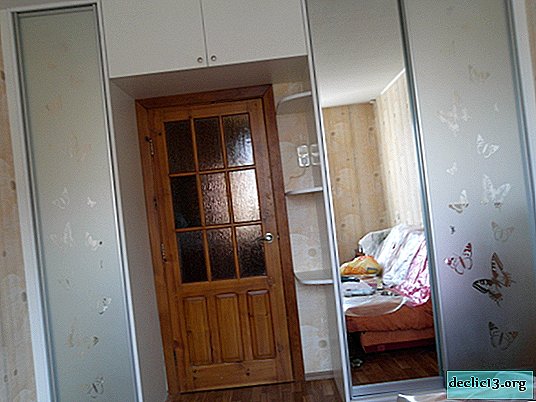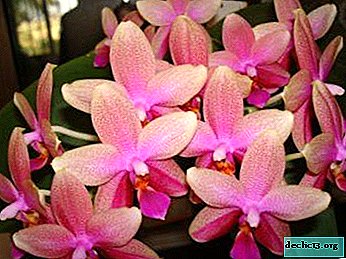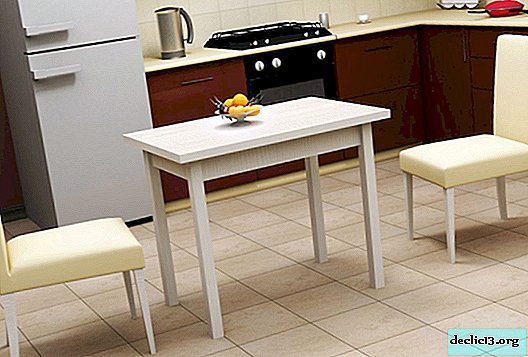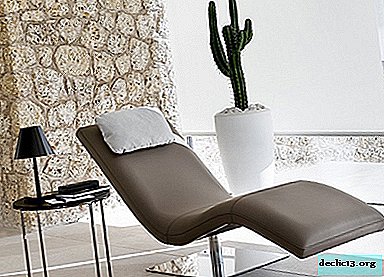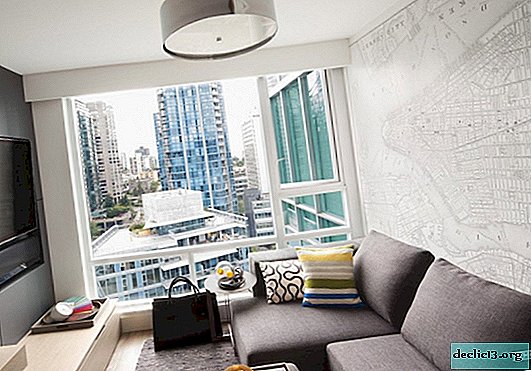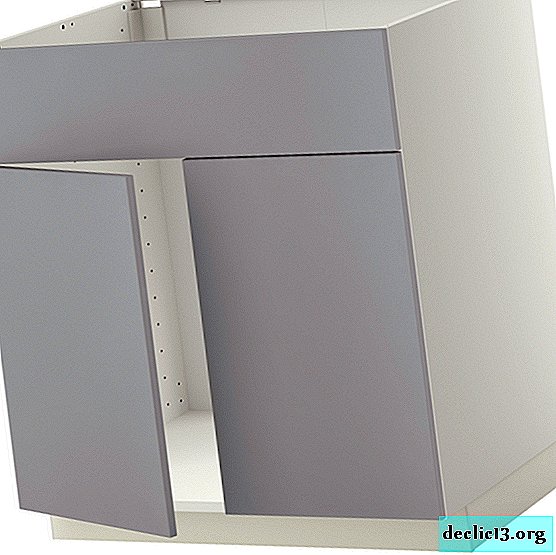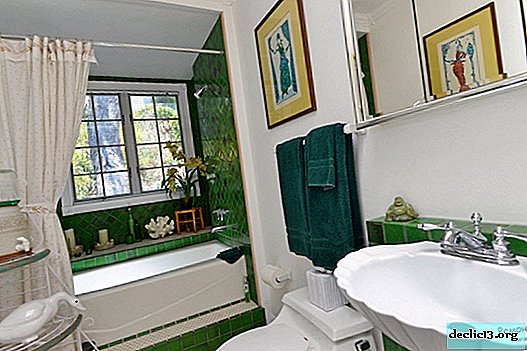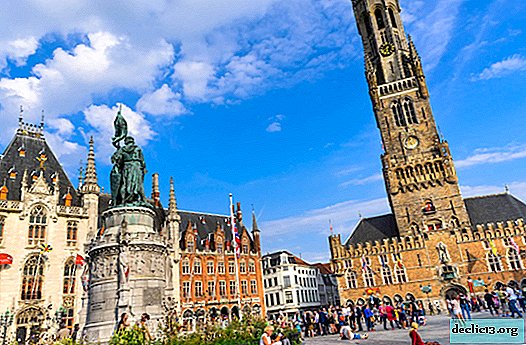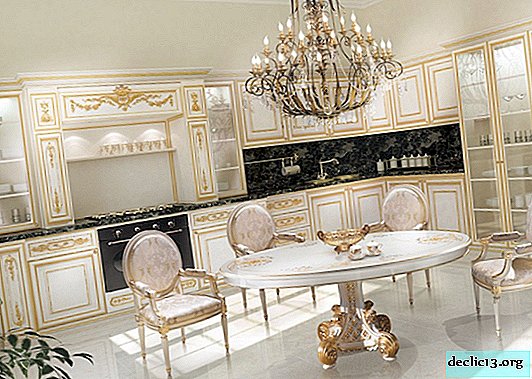Features of orchid care dendrobium at home. Useful tips and flower photo
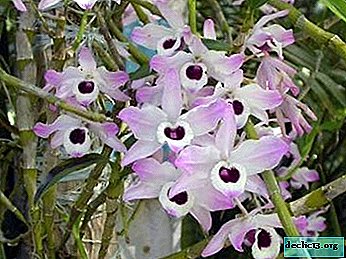
In the plant kingdom, orchids occupy one of the most honorable places, these beautiful creatures simply fall in love with themselves at first sight. Now in our apartments you can find not only ordinary, but also rare specimens, for example, Dendrobium, which means “living on a tree”.
These plants in nature and actually live on trees. How to care for them at home, what kind of land is needed and what should be the lighting, how often to water? About all this, read the article. Also watch a helpful video on the topic.
View Features
Orchid Dendrobium belongs to epiphytesand, moreover, the islands of Polynesia, South Asia and Australia are considered its most charming homeland. Among the huge number of beautiful orchids, this plant is difficult to confuse with another species. When the orchid blooms, then its trunk is almost invisible, it is all densely strewn with elegant flowers.
Two main features of the Dendrobium can be distinguished:
- root system of white color;
- the stem is erect, pseudobulbs are formed from it.
How to care?
A huge number of different types of dendrobium suggests differences in care. Scientists purely conditionally divided these orchids into 2 large groups - cool (for example, Dendrobium Nobile) and warm mode (for example, Dendrobium Phalaenopsis). Of course, there are some nuances in caring for different types of orchids. But there are several common key points that are vital to the plant:
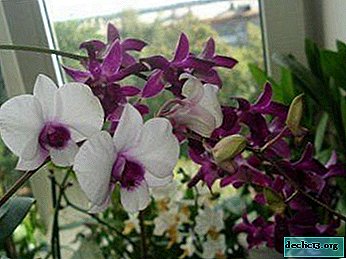 isolation from drafts;
isolation from drafts;- protection from direct sunlight;
- the level of illumination should be high, always additional lighting in winter for at least 4 hours;
- provide humidity not less than 60%;
- in the period of intensive growth (spring, summer), you need to make complex liquid fertilizers with nitrogen;
- correct soil.
If you have already decided to settle an exotic handsome man at home, then try to comply with all these rules.
Important nuances: soil, pot, location
Good care means creating a comfortable environment for your pet's environment. This means that you need to try to maximize bring the conditions of detention to its natural. It is very important to choose the right place for it, to equip it in accordance with the needs of the plant. To create for Dendrobium the microclimate he needs, taking into account the degree of illumination, humidity, temperature, and the need for feeding.
How to choose the right one:
- Pot - Dendrobium Nobile needs an opaque pot, it’s best ceramic (but also plastic), good drainage holes are required; too big a pot size will only be harmful, you need to focus on the size of the root system of the plant - it should freely enter the pot and plus 1 - 2 cm for freedom of growth.
- The earth - for our plant, pine bark will be ideal soil, its size should not be too large, about 1 cm will be enough; the shape of the bark can be any - rectangular plates or cubes, but not small crumbs (trash); You can also add some charcoal; the best drainage here is polystyrene or pebbles, because they do not absorb salts.
- Location - it will be ideal for the Dendrobium on the south window, where there is enough sunshine, north-facing windows will not be suitable for maintenance, and on the windows of the eastern and western directions, additional illumination is required. And in summer, the flower will feel great on the balcony - it can be there all summer until the beginning of autumn, when the temperature starts to drop below 13 degrees at night, you need to bring it back to the apartment.
What kind of lighting is needed?
Lighting is necessary for our orchid is bright - it should receive at least 12 hours of solar attention per day. But on hot summer days it’s better to rearrange it from the windowsill, put it on some shelf next to it or on another window (east or west). These manipulations will help to avoid burns on the leaves. In winter, fluorescent lamps or phytolamps for additional lighting will become a salvation.
How often to shower and shower?
The frequency of watering will depend on the life cycle of the plant and, accordingly, the season. In summer and spring, when our flower is actively growing, watering is needed about once a week or 10 days, well, in winter and in autumn, when the plant is resting, then watering is minimal.
The best option for watering Dendrobium is:
 Immersing it in water for 20 to 25 minutes, that is, put the pot with the plant in a basin with warm water, immerse it in about two-thirds.
Immersing it in water for 20 to 25 minutes, that is, put the pot with the plant in a basin with warm water, immerse it in about two-thirds.- Then we take out the pot from the basin and put it on some grate or net so that all the excess water is gone.
- After that, it will be possible to put the plant in its place.
You can also water it through the pan, as the orchid absorbs water, it is periodically poured. When watering through the pan, the drainage layer must be at least 3 cm.
TIP: A shower is a very good addition to watering, only a warm shower is suitable for Dendrobium, this procedure perfectly cleans dust from leaves and stimulates lush flowering. However, you should not abuse it, it will be enough to arrange a bath in the shower about once a month and in the end you will need to get excess water (in the axils of the leaves) to get wet.It is necessary to water the Dendrobium only with soft water, it must first be settled. It would be ideal for irrigation to take boiled warm water. You can also water it with filtered water, and in winter “snowy”, but cold, of course, but first melt clean snow, warm it and then water it. The flower will be very grateful.
Watch the video about the features of watering the Dendrobium orchid:
Temperature
In summer and spring, the best temperature for maintenance will be - in the range from 20 to 26 degrees. In order to get a good flowering, you need to arrange a difference of day and night temperatures of 6 - 8 degrees. Just at low night temperatures, flower buds are well laid and mature.
But in winter and autumn (at rest) the temperature is required less, it will be enough from 13 to 18 degrees. Again, it is worth noting that it is impossible to lower the temperature below 12 degrees, otherwise the plant will simply die. Also, do not test the viability of the orchid with hot air from the battery in the winter, next to the battery, the Dendrobium will not survive.
Fertilizer selection
Fertilizers must be applied from mid-spring to early fall. The best choice would be a special fertilizer for orchids (in liquid form), but diluted in half with water. Fertilizer can be applied only after the irrigation procedure, so as not to burn the roots. Sometimes it is possible to apply and foliar application - from a small spray bottle to spray on a sheet. As for the frequency of fertilizer application - you can not overdo it, you need to fertilize no more than twice a month.
IMPORTANT: Fertilizers containing nitrogen can only be added until July!Watch a video about choosing a fertilizer for orchids:
Photo varieties
Next in the photo you will see the varieties of Dendrobium phalaenopsis Dendrobium (Dendrobium phalaenopsis) and Dendrobium nobile (noble or noble):
"Dendrobium phalaenopsis"


"Dendrobium nobile"


Common mistakes
In the process of caring for orchids, you need to try to avoid common mistakes:
- do not allow stagnation of water in the pot;
- dry air is strictly unacceptable;
- you can not shade the flower;
- avoid too low temperatures;
- Drafts need to be eliminated.
Related problems
Of course, even with the most perfect care, it is not always possible to avoid problems. The main problem is the reluctance of the Dendrobium to bloom, there may be several reasons:
- overdone with fertilizers;
- the plant lacks light;
- wrong air temperature;
- humidity is too high;
- a delicate flower will never bloom in the chain smoker's room.
Another problem - the color of the shoot suddenly turns brown or yellow, this is due to excessive watering, the roots begin to rot. Sometimes, instead of flower buds, children begin to grow - it means you need to stop watering the plant for a while and rearrange it to a more illuminated place. About why the Dendrobium orchid leaves turn yellow, and how to deal with it, read here.
Conclusion
An unusual exquisite structure, a delicate aroma of numerous wonderful flowers is mainly an incentive for the acquisition and cultivation of the Dendrobium Nobile orchid at home. Do not be afraid of some difficulties in the conditions of detention. This amazing plant is undoubtedly worth all the effort that you then have to be able to enjoy gorgeous flowering.

 isolation from drafts;
isolation from drafts; Immersing it in water for 20 to 25 minutes, that is, put the pot with the plant in a basin with warm water, immerse it in about two-thirds.
Immersing it in water for 20 to 25 minutes, that is, put the pot with the plant in a basin with warm water, immerse it in about two-thirds.

